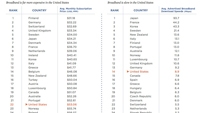Broadband stimulation means more online video usage

From President Barack Obama’s $787 stimulus package to his appointment of Internet whiz Julius Genachowski as chairman of the FCC, the expansion of broadband access is now a key part of the White House’s economy recovery program. Although politicians will publicly state otherwise, broadcasters should recognize that better access should translate to more online video usage and, thus, more spending.
In the stimulus bill, $7.2 billion was allocated for broadband expansion. The designated money is split between two government agencies: $4.7 billion to the National Telecommunications and Information Administration (NTIA, the agency that is once again distributing DTV converter box coupons), operated by the Commerce Department; and $2.5 billion for the Rural Development division of the Department of Agriculture.
In the coming weeks, these two agencies will determine exactly how the funds will be spent. Behind this huge boost in spending is a feeling that the United States has some serious catching up to do to equal the level of broadband speeds that many consumers have in other countries. Statistics show that the United States fell from fourth to 15th place in broadband adoption since 2001.
It also didn’t help that the previous Bush administration defined broadband as only 200Kb/s — a figure far lower than other nations and, to many users, a number not much faster than dial-up services. That low number skewed U.S. online performance even further downward.
For media companies — including over-the-air broadcasters and pay television providers — the risks are high in this expansion. Faster Internet service means more people in the United States will be able to receive live streaming video over the Internet. This is good news for TV stations that use live video as a way to lure audiences to their Web sites.
However, it will also speed up the trend toward great fragmentation of TV media as more program providers go straight to the viewer over the Internet. This could negatively affect local broadcasters, who depend on their networks or syndicators for programming and are developing competing initiatives like mobile television via the ATSC standard.
In the meantime, the money will be used to stimulate online connectivity, especially in rural areas. Pew Internet, a marketing research firm, now estimates that about 55 percent of the people in the United States have access to a broadband connection. Nine percent still have dial-up service.
The professional video industry's #1 source for news, trends and product and tech information. Sign up below.
The nation ranks about midway among countries for speed of service, but we pay more for what we have. For example, in London, $9 a month buys 8Mb/s of service. In New York, broadband starts at $20 a month for only 1Mb/s of access.
Telcos deliver most of the world’s broadband access over DSL. The shorter the length of the wire from the phone company central office to the home, the faster the service can be delivered. The first generation of DSL offered speeds of a maximum of 7Mb/s. The latest technology ups the speed to 100Mb/s for short distances.
One reason service is generally faster overseas — 10Mb/s-20Mbps in many European countries — is that in densely populated urban areas, the service providers have been able to wire homes using shorter connections. In the United States, phone companies could have offered a faster tier of DSL service to urban apartment dwellers. Instead, however, they chose to offer slower speeds that they could also offer in the suburbs, where most of the more affluent customers live.
During the Great Depression of the 1930s, President Roosevelt stimulated the economy with the rural electrification project, bringing the first electricity to many rural areas of the nation. When the program started, about 3 million rural residents had electric power. Four years later, the number doubled and the program ended in the early 1970s when about 98 percent of all farms had gotten electric service.
President Obama seeks the same success in the digital era with broadband services. He wants to connect every American home to the Internet. If successful, this project may change the nation just as much.
